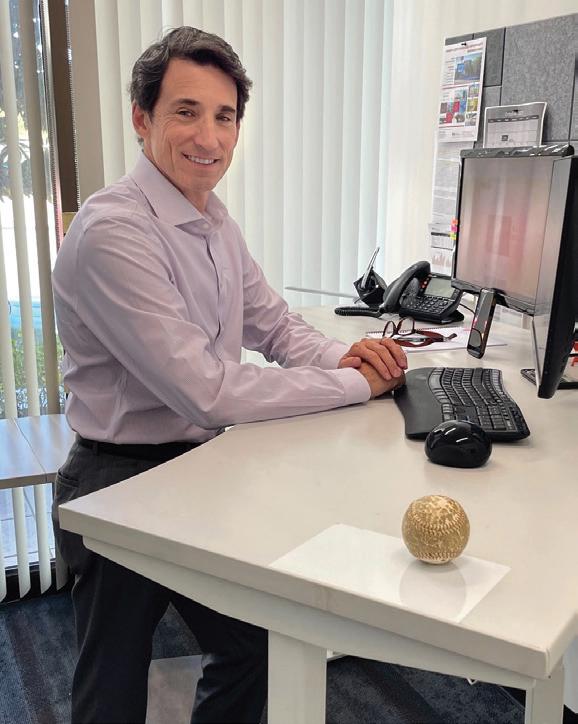
9 minute read
Managing Hybrid Workplaces
California Buildings News • Q4 2021
Managing in the Age of Hybrid Work
The Role Offices Can Play in Facilitating Workers
People. In one word, that is the most important factor in how workplaces can function best in the Age of Pandemics, which we are in for the foreseeable future. Employers need to make sure that places where their employees work are not just safe and healthy but appealing places for people. We have seen that the pandemic has somewhat empowered people. They know they have choices in a highly diversified world, choices about not only how they work but where they work. So, workplace designers and organizational planners must adjust to this new reality. They need to get to the point where people say: This is a great place to work.
Fifty-five percent of workers feel returning to the workplace is unsafe, according to a comprehensive report by Jones Lang LaSalle called “Regenerative Workforce.” JLL details a full prescription for how to make workplaces safer and more productive. Among its observations is that the three pillars of regenerative workplaces are physical health, social health and mental health.
“The post-pandemic workplace will be people-centric. It will make work easier through facilitating employees’ rhythms of energy. It will have to be designed with empathy and will be co-created with employees through understanding their perspectives, how they work and what they need to thrive,” says Chris Diming, an applied anthropologist who contributed to the JLL report.
The report stated, “The offer of health and wellbeing services has become essential to maintain a workforce at its best within a world in constant flux. Critically, these offers need to be reinforced and progressed by a commitment to sustained employee wellbeing. They need to be engrained in a company’s management and culture and involve people at every level. Leaders, naturally, have a key role to play — they must show the way ahead and embrace this new responsibility of bringing to life the Regenerative Workplace.
“It is about shaping a workplace that is ‘as comfortable as home’ and makes the most of the shared office space — where the workplace community can interact, share and head toward a common purpose. The Regenerative Workplace means bringing to an end the perceived opposites of work and wellbeing, the home and office environment, and individual needs and collective aspirations. For employers, onboarding on this journey is an incredible opportunity to create a truly reparative place for employees
and to enable them to flourish and perform in the long term.”
Successful Hybrid Workplaces Require Synergy
Beth Madrid, senior vice president of KGIP in Pleasanton, says, “With both the nearterm and projected longterm continuing fluctuation in office requirements, a successful hybrid model will rely on an increased synergy between building owners and managers and their customers. Connectivity will be integral to efforts such as implementing modified rules and regulations in common spaces, measuring ongoing occupancy levels, and notifying of confirmed cases in a building, all to ensure best security and safety practices. Additionally, with the rise in operating costs that comes with critical measures such as enhanced filtration and cleaning, engaging in frequent communication with tenants will help landlords better manage expenses by being able to institute reductions in other areas that will not adversely affect tenant satisfaction. With so many office employees grown accustomed to remote working, it will also become even more prudent for landlords’ leasing and retention efforts to create appealing common collaborative areas that offer both functional flexible meeting space and recreational elements that contribute to the employee experience. Moving forward, an enhanced partnership between tenant and landlord will be critical to establishing a safe, inviting, and viable workspace.”
John Combs, principal of RiverRock Real Estate Group in Irvine, says, “When we designed the new HQ that we purchased, we increased square footage and created a more de-densified space. We have found so far that the space is fully utilized because even on a 2-3 day alternating week schedule and having hoteling desks available that many people choose to come to the office more than their two-to-three alternating weeks and want to be where the action is, or avoid working from home with distractions, or want in person mentorship.
“Our indoor-outdoor space is popular but mostly for breaks and lunch and not to work away from everyone which is why they come in. We have very few nonvaccinated at this point even though we have not mandated it. I am so proud of where we are in this most difficult of business times. In my experience, economic cycles are not near as difficult at pandemic times.”
How Will COVID Affect Facilities Management?
San Francisco-based Boston Properties Vice President of Engineering Danny Murtagh says, “Some operating costs will go down and some will remain the same and even tick upwards. Electric, gas and water consumption has gone down and may remain lower until people return to the office leading to lower operating expenses. Consumables like paper products will decline consistent with users declining.
“Most costs will remain the same for the people still coming into the workplace as you still must operate the building systems, such as HVAC, water and lighting and power. All those services will remain the same for those in the workplace. If you consider that the office works most efficiently when it is fully staffed or on an amount per person of operation, then will buildings adjust automatically enough to maintain that efficiency, or will the per person share go up as a result?
“Maybe in newer smart buildings the adjustment will be automatic enough, but in older buildings with older technology, it may be a struggle. Regardless the buildings will still operate in a manner of comfort and efficiency, with the requisite utility support to support all its user types. Can you say that at home if you step up to a more formal office environment there and what about HVAC being on all day long? What if both the office building and home offices are in use concurrently? Will we see an increase in demand on the utility that is not sustainable? Or will the uptick be substantially offset by load reductions in the workplace? The delta variant sure gave everyone a shock when it went around and even stuck to the vaccinated people. Though not as harsh an illness for the vaccinated, it took the unvaccinated by surprise.”
CRE Brokerage During COVID
Scott Romick, principal and managing director of Lee & Associates in Southern California, says, “As a broker for 30 years, my job frequently intertwines with property management and now more than ever I am working with landlords and managers to guide them on what our tenant
Beth Madrid California Buildings News • Q4 2021


California Buildings News • Q4 2021
Hybrid Workplace Design — Both Challenging and Promising
How to best achieve effective hybrid workplace design is “a complex question,” says Architect Marsha Maytum of Leddy Maytum Stacy Architects, an award-winning Bay Area firm.
“Our home and work environments have been forever transformed by COVID for many people. The office workplace will probably never again be an eight-hour everyday static work environment. It will be a flexible place for collaboration, meetings and a resource center for teams.
“Our residences (single and multi-family) have also transformed during this time to become not only ‘home’ but also office, conference room, classroom and daycare. Flexibility in space use, technology access, enhanced ventilation systems and access to outdoors should be part of new residential design.
“Connection to outdoors has been important as expanded gathering space for people both at work and at home during the last 18 months of the pandemic. Connection to nature should be integrated into the design of our home, work and civic spaces as a source of health, well-being and community.”
Associations Provide Useful Resources for Future
The top associations concerned with the design and operation of workplaces have stepped up in an impressive way during the pandemic to give building designers, managers and operators comprehensive blueprints they need for what Arnold Levin and Albert Deplazaola say are
Photo: Adobe Stock.
The office workplace will be a flexible place for collaboration, meetings and a resource center for teams.
the “unknown unknowns.” Their recommendations for post-pandemic design in the workplace is just one of many useful sections in the
International Facility Management
Association Foundation’s recently published report Work on the Move 3 —Building Better Workplaces after the Pandemic.
In another section of the report, Alexi Marmot and Michael Schley say, “Whatever new future knowledge emerges, the power and value of remote working, that has been thoroughly tested on a grand scale and generally proven robust during the pandemic, is now more widely appreciated than ever before.”
Schley and Pat Turnbell report that since 41% of people say they are planning to change jobs, a new
“purposeful” workplace should be envisioned to accommodate new workplace practices. “Employees want to control when, where and how they work,” they say.
“Research shows that flexibility and hybrid work will define the post-pandemic workplace.” The workplace should be a strategic asset supporting people, culture and business outcomes. New ways of working demand understandings, processes, practices and work arrangements. For more information visit: foundation.ifma.org.
Valuable insights are also available in a variety of reports and studies sponsored by the Building
Owners and Managers Association
International and www.boma.org, the American Institute of Architects at www.aia.org and the Institute for Real Estate Management at www.irem.org.

Managing Hybrid Work (Continued from page 7) clients want and need. No one knows how long the hybrid workforce model will last, but it is here for a while and that forces the hands of landlords and property managers to adapt to accommodate this new way of work life.
“Properties are being renovated to allow for more than just a pathway to the front door of the office as people just do not sit at their desk all day. The campus feel of the creative tech properties is being adapted to fit the environment of Class A high rises as well as suburban offices. It used to be that companies created a fun workplace environment to attract talent, but now it’s the landlords who are being resourceful to attract tenants, and more so their employees, to come back to their offices. Since our place of business is not just one place anymore, it's many places…the office, your home, on the road etc., buildings are improving their telecom connectivity to help accommodate their client tenants’ needs. Technology will also be an integral part of the design to adapt to the new work and traffic flow within the building with regards to HVAC hours, secured touchless entry and energy supply for variable hours. Cycles come and go, and now it’s time to learn to ride this one.” n




